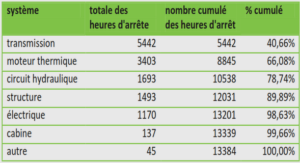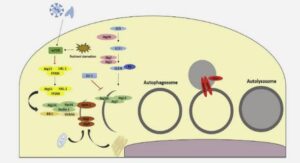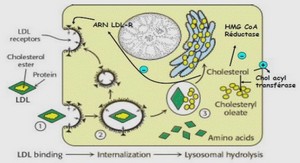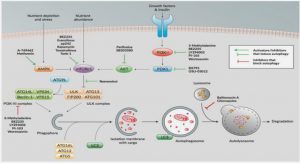Surface deposit and drainage classes
SIFORT types of surface deposit and drainage classes uses data from ecoforestry maps and follows the nomenclature of the Ministère des Ressources Naturelles (1994). For both ecological regions, 27 types of surface deposit and 6 drainage classes were identified. For the purpose of our analysis, we summarised this information into 3 fertility classes (Table 2.3), which represent site quality for tree growth. Rationale for this is the relationship between soil productivity class (surface deposit and drainage) and species productivity found by many authors (Cartier et al., 1996, Harvey et al., 1996, Béland and Bergeron, 1996). The three productivity classes are: fertile, poor with good drainage and poor with poor drainage. The fertile class include glacial and lake deposits. Glacial deposits are formed by different till sizes ranging from clay to gravel. Lake deposits are composed of organic matter, fine sand, stratified silt and clay. When these soif deposits are associated with fast, good, moderate and imperfect drainage (1 ,2,3 and 4) they form fertile sites favourable to vegetation growth. The poor with good drainage fertility class are made of rocky outcrops with thin soils and coarse grain. Associated with low moisture retention, these surface deposits form poor soi!s with fast drainage (1 to 4), which are less favourable to forest development. The poor with poor drainage fertility class has organic soils and surface deposits associated with poor drainage (5 and 6). These sites are not favourable to species growth and are usually operi canopy stands.
Age classes Stand age classes provided by ecoforestry maps are determined by photointerpretation using a combination of stand composition and height. Age classes are based on 20-year classes with a maximum of 120 years (10, 30, 50, 70, 90, and 120 years). When stands originate from fire disturbance (most common case in our data set) and are relatively young (less than 100 years), the age estimation is relatively good (Gauthier et Lefort unpublished). If a stand has two age classes it is considered an uneven-age stand. ln such cases, the average of the two age classes was used as the stand age. The combined age class of each stand type is used tc determine modal age of species communities.
Assessment of arboreal succession Transition matrices are used tc assess arboreal succession. They are constructed using the 1985 and 1994 SIFORT databases (SIFORT 2 and SIFORT 3) – the 1969 SIFORT database (SIFORT 1) is not use for this analyse because of it lacks of precision. They .allow the evaluation of stand evolution (i.e. composition change) between two inventories by providing transition rates (difference between stand types abundance in SIFORT 2 and SIFORT 3). Polygons showing recent natural or anthropogenic disturbances (fire, insect outbreak or cutting) and non-forest area have been excluded from the analysis. The reduced database contains natural productive stands that have n()t been disturbed since 1970. This database contained 60 459 polygons: 26 059 for the Ables balsamea-Betula papyrifera ecoregion and 34 400 for the Picea mariana-feathermoss ecoregion. These polygons include 18 % of the initia! S!FORT database. Among the excluded polygons, 52% have been harvested, 19 % have burned and 2.9 % were affected by a severe insect outbreak. The other polygons were rejected because of diverse anthmpogenic or natural disturbances (such as windfall, light insect outbreak, agricultural use) and other (nonforested dry or wet lands, open water, etc.).
Differences in successional pathways between ecoregions
To determine if there were differences between successional pathways in relation to the ecoregions, SfFORT 1 (1969) and SIFORT 2 (1985) databases were used. Polygons containing Abies balsamea polygons are more abundant in SIFORT 1 than in SIFORT 2 and 3 due to the fact the aerial photographs were taken before or at the beginning of the spruce budworm outbreak. Therefore, SIFORT 1 was kept’ in our analysis and polygons affected by the outbreak were added to data used to construct the transition matrix. The number of polygons affected by the outbreak between the two inventories was determined by the transitions towards severe outbreaks in SIFORT 2. This new set of data was used to calculate transition matrices for each ecoregion. Only transitions towards stands affected by the outbreak and towards late successional stands are presented.
Change in serai stages composing a successional pathways Figure 3.1 presents changes in polygon distribution between the last two inventories (SIFORT 1985 and 1994). Negative values correspond to a decrease in area percentage caver of a stand type in SIFORT 3 when compared to SIFORT 2. Positive values correspond to an increase in percentage caver of a stand in SIFORT 3. Polygon distribution shows differences in the nine years between the last two inventories. The frequency of early successional stands, such as Betula papyrifera, Pinus banksiana, Popu/us tremuloides-coniferous and coniferous-Popu/us tremuloides decreased while mid and late successional stands increased. The number of Picea sp. stands also decreased between the two inventories. This reduction could be due to disturbances that were not identified or due to errors in stand identification.
Succession study Table 3.1 shows transition rate between stands for the whole territory. Five to forty five percent of polygons for each stand type were not used for calculating transitions because they presented aberrant transitions (e.g. pure Pinus banksiana stands changing to pure Betu/a papyrifera stands). The global transition rate refers to the number of stands showing a change in their serai stage. The global transition rate for stands ranged from 23 % to 46 %. ln other words, within nine years, the majority of stands remained in the same successional stage. Betula papyrifera stands present high transition rates (31 to 46 %). Pinus banksiana stands have transition rates a little lower than Betula papyrifera stands. For these two stand types, the successional trend pathways indicates that Picea mariana is gradually taking over the canopy.
Successional rate Analysis of succession speed for ecoregion was done only for fertile sites because the number of polygons was too low for poor sites (with good or poor drainage) to be representative when subdivided by ecoregion. Figure 3.4 shows the differences of forest evolution between ecoregions. ln the Abies ba/samea-Betula papyrifera region (Figure 3.4 a), Pinus banksiana stands are the first to disappear from the landscape wheras fn the Picea mariana-feathermoss region (Figure 3.4 b) Betu/a papyrifera stands disappear first. For both regions, Popu/us tremuloides stands are the last to be replaced. The decline of early successional stands in the landscape is faster in the Picea mariana-feathermoss region than in the Abies balsamea-Betula papyrifera region. Table 3.3 shows that time necessary tc observe a decrease of 50 % of the initial caver for each species in Picea mariana-feathermoss region is shorter than in the Abies ba/samea-Betula papyrifera region. Time for a decrease of 50 % of the caver shows a 2-year difference for Pinus banksiana stands, 8 years for Populus tremuloides stands and 6 years for Betula papyrifera stands. Furthermore, Populus tremuloides stands persist longer in the Abies balsamea-Betula papyrifera region than in the Picea mariana-feathermoss region.
Liste des figures |






